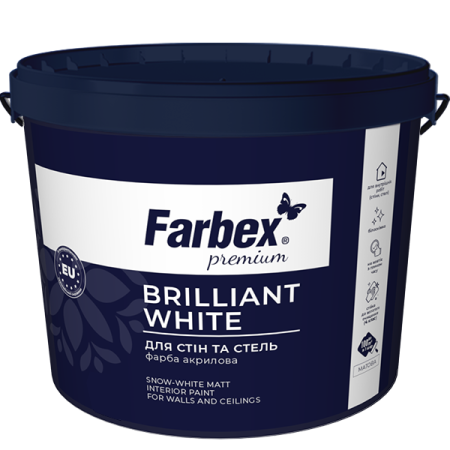
Farbex
Brilliant White
Paint for walls and ceilings
Specification
Snow-white paint with a high application rate. Due to its high degree of whiteness, it visually enlightens space. It doesn't yellow through the time. It creates matt coating which lets the walls "breathe" well. It is applied easily, doesn't run and splash while applicating. It is resistant to wet cleaning (wet abrasion resistance - 4 class acc. to DSTU EN 13300).
Sphere of application
It is intended for interior coating of all mineral (mortar and lime-mortar plaster, finishing plaster, brick, concrete), gypsum and wooden surfaces, wallpaper and fiberglass. It is recommended for coating of walls and ceilings in dry spaces with moderate exploitation load: living, administrative spaces, medical, infant and educational establishments, spaces of catering and industrial enterprises.
Tinting
It can be tinted manually with Pigment Concentrate Farbex Color, other waterborne coloring pastes or with a coloring machine acc. to NCS color range and others.
Technical data
| Consumption standard of 1 layer | 140-175 g/m2. Depending on the way of application and type of surface |
| Thinner | Water. Maximal allowed delution is 10 % of the total weight of the product |
| Application | It is applied with a roller, a brush or a spraying gun. |
| Drying period (23 °С, 50% RH) | max. 1 hour. Drying period increases while the temperature is getting lower and the relative air humidity is getting higher. |
| Solids content (DSTU ISO 3251) |
57±2 % |
| Density (DSTU ISO 2811-1) | ≈ 1,52 g/cm3 |
| Gloss (DSTU ISO 2813) | Max. 10 GU at 85°, (matt, SSU EN 13300) |
| The degree of milling (SSU ISO 1524) | max 30 microns, (fine grained, SSU EN 13300) |
| Contrast ratio of dry film (ISO 6504-3) | 97,5 - 98,5 %, 3 class of hiding power (acc. to DSTU EN 13300) |
| Wet-scrub resistance class (DSTU EN 13300) | 4 |
| VOC content (ISO 11890) | < 10 g/l. |
| Warranty period | 24 months from the date of manufacturing (at the temperature from +5 °С till +35 °С) |
| Packaging | 1,4 kg, 4,2 kg, 7 kg, 14 kg, 20 kg |
Gloss
Color
Application instruction
-
1. Surface preparation
Uncoated surfaces: Clean the surface from fragile parts till the hard base surface. Remove dust, oil, grease and other dirt.
Previously coated surfaces: Clean thoroughly the surface from old loose coatings (loose paint or varnish) in mechanical (a scraper, a wire brush), thermal (a hot air dryer, infrared radiation), or chemical (a paint removal solution) ways. Remove chalk and lime-chalk coats till hard surface in a mechanical way. The surface shall be also clean of other dirt. Sandpaper the surface previously coated with alkyd and oily enamels. After these preparation treat the surface as the uncoated surface.
Correct small defects of the mineral surface with Finishing putty TM Farbex and then sandpaper the surface.
It is recommended to treat the surface with antiseptic solution TM Farbex for protection against mold and fungi.
2. Priming
Previously treated wooden and mineral surfaces need no undercoating.
Previously untreated absorbing mineral surfaces shall be treated with deep penetrating primer TM Farbex.
Previously untreated wooden surfaces shall be primed with wood protective acrylic primer TM Maxima.
3. Applying of finishing layer
Stir the paint thoroughly before use. The temperature of the air and the surface under application shall be from +5 °С to +35 °С and relative air humidity less than 80%. Apply the paint with 1-2 coats with a brush, a roller or a spraying gun.
4. Tool cleaning
Clean tools with water after application. Do not let them dry. The dry product shall be removed from the tools in a mechanical way.
Tips

How to coat a ceiling without problems?
The fact is that coating of a room with waterborne paints shall be started from the ceiling. There is certain sequence of work you should keep: At the beginning, we must prepare the surface:: 1. Cleaning It is necessary to …
Flow calculator
Consumption standard of 1 layer
When calculating the area to be painted, you need to subtract the area that will not be painted. (windows, doors, etc.)
Paint consumption may vary depending on dilution and uniformity of application of the paint.